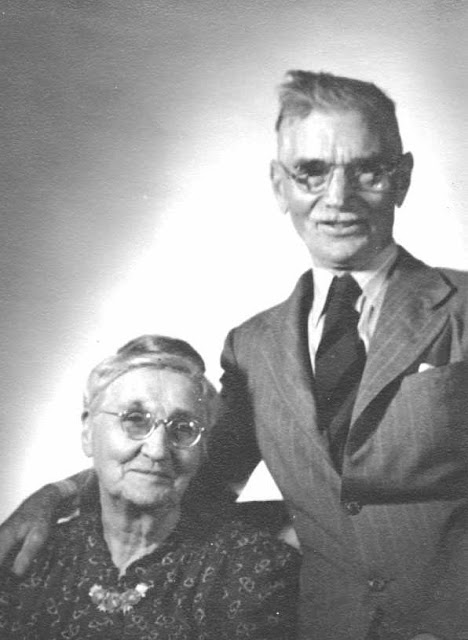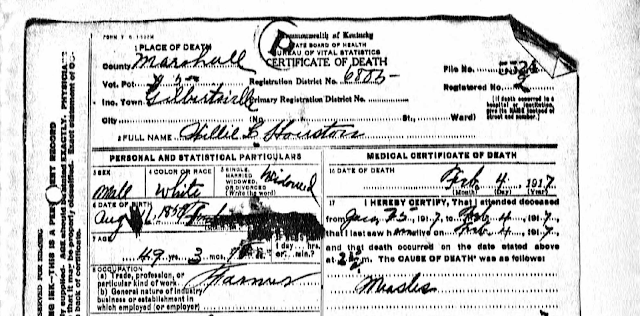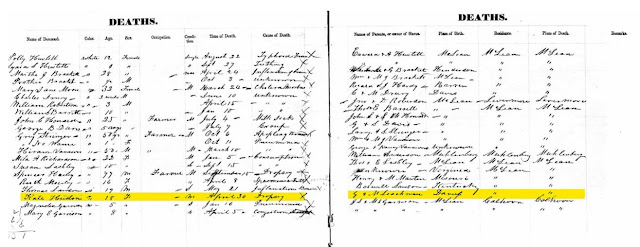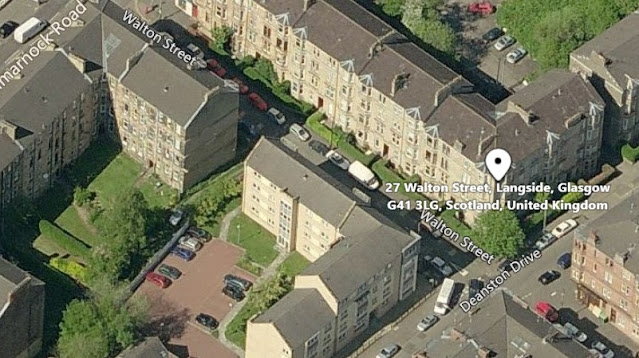Struggling for
Success in Suriname and America: Father’s Day Part II
John Sutherland Shields: 1865-1959
Item from the Paramaribo Newspaper De West-Indier :
dagblad toegewijd aan de belangen van Nederlandsch Guyana, 24-08-1892, Dag ; no.
68 (KB), translated from Dutch to
English:
The saw mill
business lately carried on by Mr. Andrew Mc Connachie at Plantage Alliance, will be continued
under the management of Mr. John Shields who will receive and execute orders. Mr.
H. Mc. Robertson, 49 Domine St. Paramaribo, will continue to act as Town Agent and
will also receive orders.
All accounts
must be paid to Mr. John Shields at Plantage Alliance, or to Mr. Robertson , Paramaribo.
A.G. Knott
& Co.
Alliance,
August 13th 1892
John Sutherland Shields and Jane
Pollok married in Glasgow on June 1, 1892, and by August 13, they were living
at Plantage Alliance with several Shields family members, including John’s
father Thomas, John’s older brother Archie, and quite possibly his sister
Bethia’s family. As we can see from the newspaper notice, Thomas Shields was
still working for A. G. Knott—he wouldn’t buy Alliance from Knott until a few
years later. But Thomas had enough influence over the plantation’s management
that he was able to hire his son to manage the sawmill, a position for which John
had no experience.
There is little information about
John and Jane’s time at Alliance. Ruth Shields McNiven told John and Laurel
Aird that John Shields chafed under his father’s and brother’s direction and
control. Laurel’s notes read, “John’s father and brother Archie both authority
figures and John didn’t get along with either. John became same sort of
father—hardest on Archie.”

Jane got pregnant while in Suriname,
and gave birth to Mary “May” Seller Shields in Paramaribo on May 14, 1893. By
this point, the relationship between John and his father was deteriorating. I
can find no records to indicate whether John quit his sawmill job, or whether
his father fired him. All that I know for certain is that John, Jane and May
appear on the 1900 U. S. census, living in Hamilton Ohio, and they responded to
the census question about when they immigrated by saying they arrived in 1893
and had been in the U.S. as “aliens” for six years. This suggests an arrival
date late in 1893—they probably waited to travel until May was at least several
months old.
Why did they choose to travel to the
United States to live instead of returning to Scotland where they had family
members and friends? I don’t believe they knew anyone in Ohio, so how and why
did they end up there? And why did they resist becoming citizens for so long?
Did they still consider heading back to Scotland? They didn’t become
naturalized for decades.
John worked as a machinist in
Hamilton. The family grew while they lived there. Margaret Shields was born
October 15, 1896. Archibald Shields was born September 7, 1899, and Bethia Jane
Shields was born Octobert 31, 1901.
 |
| Jane and John Shields and their children, early 1950s |
John and Jane’s youngest daughter,
Ruth Shields, was born in Detroit on October 2, 1904, so we know the family moved
at some point between July 20, 1904 when Jane’s sister Maggie wrote to her in
Hamilton (see next post which includes letter), and October, when Ruth was born.
 |
| Hamilton Ohio house the Shields family rented |
So why did the family move 250 miles
north? Did John get a better job opportunity in Detroit? By the 1910 census,
John is working as a machinist at a “jobbing shop”. The family was living at
190 Horton Avenue, and had two lodgers, both machinists working at an auto
plant. (Note: I think the actual street name was Horton Street, not Avenue.
Today the 100 block of Horton has been razed, but the 200 block still has
several sizeable two-story homes, probably similar to the one the Shields
family lived in.)
In 1911,
John took out a patent on a mechanical movement for engine valves, sharing the
patent with a W. Lamb. Obviously John was still using his engineering skills.
At some point, John invested in a
monkey wrench company in the town of Howell, Michigan, about fifty miles from
Detroit. Ruth mentioned it in passing when she talked to John and Laurel, noting,
“John Shields started a monkey wrench business in Howell, and his partner
absconded with all the funds.”
I found several articles in the
Howell newspaper about the wrench factory. John Shields’ role is rather murky,
but despite Ruth’s claim, he was not one of the founders. The company was
called the Ewer Wrench Company, and E. A. Bowman and M.J. Ewer appear to be the
initial investors and founders. The company began building a factory in 1911,
but ran into financial problems and had to take out a sizable loan as well as
sell stock. The founders claimed at the time that the company already had
orders for 25,000 wrenches.
John Shields was elected to the
Board of Directors of Ewer Wrench on January 17, 1912 (see article below). Perhaps
he bought some of the stock sold in 1911, giving him a partial stake in the
company. It is unclear if he was also working for the wrench company, or if he
was still a machinist in Detroit. Ruth implied that the family had moved to
Howell, but the article states the new board members were all from Detroit.
The company was failing by early 1913.
A scathing article about Ewer Wrench’s closing ran in the April 2, 1913 Howell
newspaper. The article noted that after $15,000 was raised through stock sales and
an additional $3500 in loans were taken out, “still no wrenches were put on the
market. Finally work stopped and a few thousand wrenches were almost given away
and that money was dumped somewhere so that it did not go to pay debts. Things
went from bad to worse until the special meeting Monday night voted to wind up
things and go out of business; that is if they were ever in business.” The article
also noted that the investors lost nothing but the face value of their stock—which
means they lost everything they had invested.


According to Ruth, the Shields
family suffered a serious financial setback from the wrench factory failure. Laurel’s
notes state “Neither our May nor Margaret allowed to finish high school. Had to
go to work to help out…” Ruth also told the Airds that, “When the family moved
again, May stayed with the Bowmans, boarding. Still very much docile. Dated a
boy who later became leader of the Howell Band. Bruce something?” I was
interested to note that one of the two initial investors in the Ewer Wrench was
E. A. Bowman. Obviously John Shields didn’t blame Mr. Bowman for the company’s
failure if May ended up living with the family. It sounds as if the Bowmans
lived in Howell. I believe the “Howell Band” is a reference to the Plymouth
Brethren church.
By the advent of World War I, John
was working for the Maxwell Motors Co. in Detroit. A Detroit news article
recognizing contributions to a fund for area soldiers printed John’s letter on
behalf of his fellow workers:
“John S.
Shields sent the following letter with the big Christmas gift [of $272.94]: ‘We
of the Maxwell Motor company, Oakland Avenue, have come again with our
bi-monthly contribution to the Tobacco Fund for our boys at the front. We have
chipped in a little extra this time for a Christmas special.’”
 |
| 1915 Maxwell Motors model John Shields may have worked on |
Maxwell Motors ended up being bought
out by Chrysler after the war. By the time of the 1920 census, John reported
that he was an engineer at a “foundry”. That doesn’t sound like Chrysler, but
since the 1930 census finds him at age 65 working as a machinist at an “auto
factory,” it might have been. The family was still renting a home in 1920, but
by 1930, they finally owned their own home—the first property they owned in
nearly 40 years of marriage. John probably bought the house, located at 8939
Mendota in Detroit, new since it was built around 1920. John told the 1930 census
taker it was worth $10,000. The house still stands today.
 |
| 8939 Mendota, Detroit |
After John’s retirement, he and Jane
moved to Zephyrhills, Florida, near Tampa. Jane died June 21, 1954, and John
died January 9, 1959 at the age of 93. The brief obituary noted he was
grandfather of 19 and great-grandfather of 10. His eleventh great-grandchild,
Bruce Aird, was born seven months later in August 1959.

John Sutherland Shields chose to
forge his own path. He broke free of his father and brother’s expectations and
made his own way in America. Ruth told John and Laurel that “his own family
considered him a rolling stone.” Ruth implied that he was not the best provider
for his family, pointing out that her oldest sisters had to forego attending
high school to help support the family. She also noted that when John’s mother
died in Scotland, Ruth’s husband Jack McNiven paid John’s travel expenses so that
he could attend the funeral. However, she neglected to note that John had just
traveled to Scotland a few months earlier to attend his mother’s 100th
birthday celebration, so it is not surprising that a retiree might not have the
funds for two trips to Scotland in one year. John managed to achieve the
American Dream, buying a home and enjoying two decades of retirement in Florida.
His large family of descendants can be proud of his persistence, independence
and accomplishments.










































